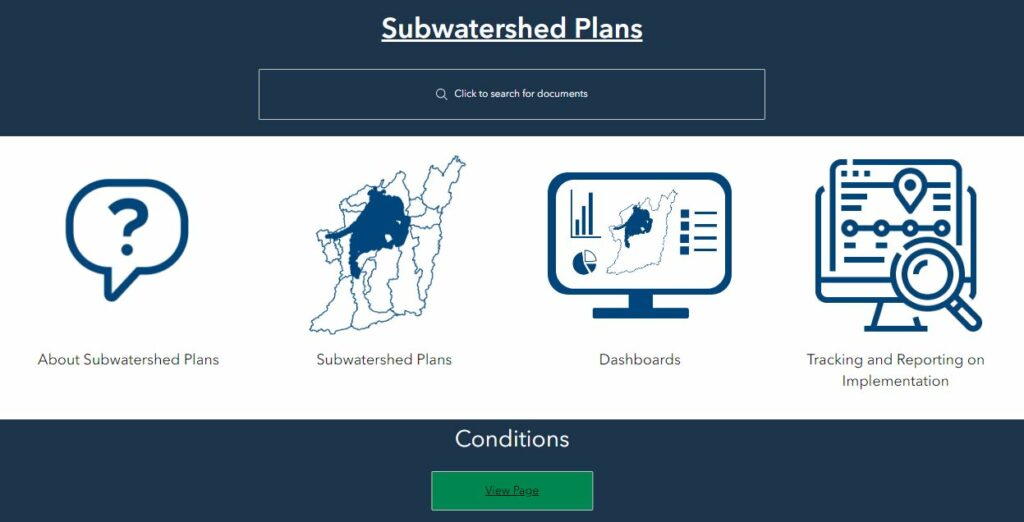Subwatershed Plans
About Subwatershed Plans
Watershed planning is a process that involves characterizing the health of the watershed, identifying stressors affecting its health, selecting preferred solutions to protect, enhance, and restore watershed health, and then monitoring progress and adapting recommendations and activities to achieve desired outcomes. They provide an integrated understanding of watershed health, including the natural heritage and water resource systems. This understanding helps to inform decision makers on how their decisions will affect watershed health. The Lake Simcoe Conservation Authority’s jurisdiction encompasses the entire Lake Simcoe watershed, with each of its contributory river systems being considered a subwatershed. Therefore, what we describe as “subwatershed plans” are equivalent to what other conservation authorities and some provincial policies refer to as “watershed plans.”
About the New Subwatershed Plans Online Platform
The Subwatershed Plans Online Platform is an interactive tool to explore the subwatershed plans, provide up-to-date detailed and interactive mapping and data, and link to other relevant resources. It was designed for subwatershed plan users, including municipal and provincial staff, other conservation authority staff, and First Nations representatives. Within this platform, you will have access to the individual subwatershed plans, explore indicators in detail, access a dashboard where you get to interact with the findings, and find what you are looking for with ease. .
How to Use the Platform
When you click the Subwatershed Plans Platform link, you’ll see a landing page that looks similar to a website. Each tab along the top in the navigation will bring you to a new page; these include the subwatershed plans, an overview of watershed conditions, interactive maps, content, and links to our online mapping and data.
When viewing the Water Quality dashboards, you can click a point on the map to populate the elements, which provides more information on the selected station.
When using the Climate Change infographic and Land Use Change dashboard, click on the tabs below certain elements to view more information. Additionally, the categories in the Surface Type Allocation graphs are interactive, allowing users to click on them to apply a filter.
When you select a Conditions page and start scrolling, you’ll see a series of links appear at the left of the page. Keep scrolling down to view all of the content or use these links to navigate to a specific area of interest.
We also encourage you to read the tips and FAQ below.
Need some help? Send us an email or give us a call at 905-895-1281.
Tips and FAQs
To view a full screen version of an element in a dashboard (such as a line graph), click the button in the top right corner of that element.
The platform is best viewed desktop and not mobile. If you are on mobile and looking for the subwatershed plan PDFs they can be accessed below.
For the best experience, use the in-platform navigation options as much as possible – avoid the ‘Back’ and ‘Forward’ buttons in your browser
If there are issues with display or loading data on a page, please reload the page. If that doesn’t work, please fill out the “Providing Feedback” section (on the bottom of the home page) and let us know.
Instructions on how to use the Subwatershed Plans and dashboards are provided on their respective pages.
- Subwatershed Plans page: Top right of the map
- Water Quality and Land Use Change dashboards: Sidebar (can be hidden or pinned, so it is always viewable)
All tables and graphs can be clicked on to view a full screen version that will open in a new tab
The Subwatershed Plan Online Platform is under development and some pages are still “coming soon.” Please bear with us as we update that content. If you cannot find what you are looking for, please get in touch with us using the contact information below.
Subwatershed Plan PDFs
This subwatershed plan looks at the Barrie Creeks, Lovers Creek, and Hewitt’s Creek subwatersheds, located in the west-central portion of the Lake Simcoe watershed around the tip of Kempenfelt Bay. These subwatersheds fall mainly within the City of Barrie and Town of Innisfil, with very small portions found in the Townships of Oro-Medonte and Springwater.
Barrie Creeks, Lovers Creek, and Hewitt’s Creek Subwatershed Plan (Published: 2012)
Implementation Plan: 2013-2017 (Published 2012)
The Beaver River is the Lake Simcoe watershed’s easternmost subwatershed. The subwatershed is 327.3 km2 in area, with 85.1% of its area within Durham Region and the remaining 14.9% within the City of Kawartha Lakes. The subwatershed includes the Townships of Brock, Scugog, and Uxbridge and the communities of Beaverton, Cannington, Sunderland, Blackwater, Lorneville, Woodville, and Derryville.
Beaver River Subwatershed Plan (Published 2012)
The Black River subwatershed occupies 375 square kilometres of land south of the eastern portion of Lake Simcoe. With the headwaters originating on the Oak Ridges Moraine, the Black’s watercourses flow mainly through natural features and agricultural areas throughout much of the system before reaching the community of Sutton and the outlet into Lake Simcoe.
Black River Subwatershed Plan (Published 2010)
This subwatershed plan looks at the lakes, rivers and tributaries that make up the Canal and Mitchell Lakes, Talbot River, and Whites Creek subwatersheds, located in the northeast of the Lake Simcoe watershed. The subwatersheds fall within the upper tier municipalities of Simcoe County, Durham Region, and the City of Kawartha Lakes, as well as the lower tier municipalities of the Township of Ramara and the Township of Brock. The Whites Creek and Talbot River subwatersheds are 10,540 ha and 36,908 ha in area, respectively. Canal and Mitchell Lakes are located completely within the Talbot River subwatershed and measure 846 ha and 275 ha in area, respectively.
Canal and Mitchell Lakes, Talbot River and Whites Creek Subwatershed Plan (Published 2016)
Canal and Mitchell Lakes, Talbot River and Whites Creek Implementation Plan: 2016 – 2021
The Holland River is located in the southwest corner of the Lake Simcoe watershed. It is composed of two major tributaries, the East Holland and the Holland/Schomberg. The East Holland River is the smaller of the two, draining approximately 243 square kilometres, or 41%, of the total subwatershed.
East Holland River Subwatershed Plan (Published 2010)
York Region Subwatershed Implementation Plan: 2013 – 2017 (Published 2013)
This subwatershed plan studies the three islands and mainland area that make up the Georgina, Fox and Snake Islands subwatershed, located in the southern portion of Lake Simcoe. The subwatershed is owned by the Chippewas of Georgina Island First Nation and falls within the Regional municipality of York. The total subwatershed area is 1.4 km2, comprising 0.5% of the Lake Simcoe watershed.
Georgina, Fox and Snake Islands Subwatershed Plan (Published 2017)
This subwatershed plan looks at the tributaries that make up the area known as the Innisfil Creeks subwatershed, which drain into the western side of Lake Simcoe, including Cook's and Kempenfelt Bays. Almost all of the subwatershed area falls within the Town of Innisfil, with 3% falling within the City of Barrie and 1% in the Town of Bradford West Gwillimbury. The subwatershed is 107 km2 in area, and consists of 17 named streams, most of which have their headwaters in agricultural areas, and then flow downstream, some through urban areas, before entering the lake.
Innisfil Creeks Subwatershed Plan (Published: 2012)
The Maskinonge River subwatershed is located in the south-central portion of the larger Lake Simcoe watershed. It has a drainage area of approximately 60 square kilometres, a little more than two percent of the entire Lake Simcoe watershed. Since the mid-1980s, the Maskinonge River has been plagued by the excessive growth of algae and aquatic plants, most noticeably duckweed.
Maskinonge River Subwatershed Plan (Published 2010)
This subwatershed plan looks at three separate, but fairly similar, subwatersheds lying in the northwest portion of the Lake Simcoe watershed, with their headwaters originating on the Oro Moraine: Oro Creeks North (75 km2 within the Township of Oro-Medonte, with just over 20% falling within the City of Orillia), Hawkestone Creek (48 km2 entirely within the Township of Oro-Medonte), and Oro Creeks South (57 km2 also fully within the Township of Oro-Medonte). This subwatershed plan was prepared under the direction of the Lake Simcoe Protection Plan (LSPP).
Oro & Hawkestone Creeks Subwatershed Plan (Published 2013)
Implementation Plan: 2014 – 2018 (Published 2013)
The Pefferlaw River subwatershed is approximately 425 km2 in area, located on the eastern side of the Lake Simcoe watershed. It lies almost entirely within the Regional Municipality of Durham, with a small portion in York Region. It includes the Townships of Brock, Scugog, Uxbridge, and Georgina, and the communities of Pefferlaw, Udora, Sandford, and Siloam.
Pefferlaw River Subwatershed Plan (Published 2012)
This subwatershed plan looks at the tributaries that make up the Ramara Creeks subwatershed, located in the northeast of the Lake Simcoe watershed. The subwatershed falls entirely within the Township of Ramara, and includes the communities of Brechin, Bayshore Village, and the unique canal community of Lagoon City. It is 137 km2 in size, and consists of a number of tributaries, many of which are primarily municipal drains flowing through agricultural areas. These include the Donnelly, Gettings, McNabb, Harrington, Murray, O’Connell, and Ross Drains, as well as a natural watercourse called Wainman’s Creek.
Ramara Creeks Subwatershed Plan (Published 2015)
Implementation Plan: 2015 – 2020 (Published 2015)
The West Holland River subwatershed occupies 354 square kilometres of land immediately to the southwest of the tip of Lake Simcoe’s Cook’s Bay. Originating on the Oak Ridges Moraine, the headwaters of the subwatershed flow through mainly forested and agricultural areas before entering the Holland Marsh. The system then flows past the Town of Bradford, and then past forested and agricultural areas before discharging into Lake Simcoe.
![]() Who to Contact
Who to Contact
Integrated Watershed Management
✆ 905-895-1281
✆ 1-800-465-0437 Toll free 
 Accessibility
Accessibility
We are committed to providing a website that is accessible to the widest possible audience, regardless of technology or ability. We are actively working to increase the accessibility and usability of our website and our documents.
If you require any content in an alternate format, please contact us at 905-895-1281 or by email at accessibility@LSRCA.on.ca

